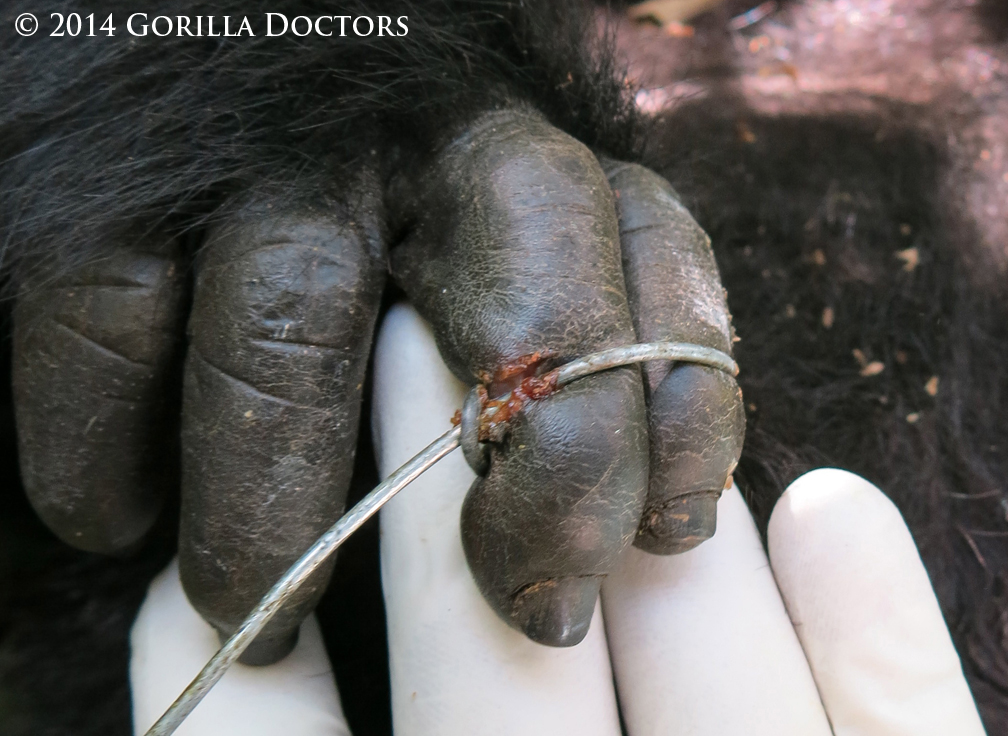Baby Mountain Gorilla Freed from Snare in Virunga National Park’s Mapuwa Group
By Gorilla Doctors Staff on Wednesday, May 28th, 2014 in Blog.By Dr. Jan Ramer
Dr. Eddy, the Head Veterinarian for Gorilla Doctors in DR Congo was notified that a mountain gorilla had become ensnared in Virunga National Park’s Mapuwa group on May 21st. Since Dr. Martin was doing Routine Health Checks at Mt. Tshaiberimu and could not assist with the intervention, I immediately traveled from our headquarters in Musanze, Rwanda to meet Dr. Eddy in Goma, DRC. From there, we made the 1.5 hour drive to the Virunga National Park headquarters in Rumangabo.
Mapuwa group is accessed from the Jomba patrol post in PNVi, so Eddy and I stayed in Rumangabo so that we could get to Jomba early the next morning. We arrived to the Jomba patrol post the following morning at 8:30am after a 2-hour drive on some pretty challenging roads.
We started walking from the patrol post at 9am, reaching the forest edge in about an hour. Unfortunately we did not find the gorillas until 2:30pm – crazy that gorillas can hide in the forest, but they can! The gorillas were slightly suspicious of our field team, presumably because they are typically not visited that late in the day. With 3 silverbacks and 2 blackbacks, the group is very well guarded!
Dr. Eddy and Virunga National Park trackers look at GPS coordinates to try to determine the location of the group.
We got a pretty clear observation of the ensnared female gorilla, but there was no opportunity for a good “shot” with anesthesia to remove the snare. We had to stop trying at 4pm so that we could walk back to the patrol post (by the time we found the gorillas the patrol post was 1.5 hours walk) and find a place to stay before dark. It was a long, tiring and frustrating day.
Once we were back out of the forest, we drove about an hour to Bunagana and found a guest house where we could stay the night. We set out very early the next morning and luckily found the group by 9am. They were feeding and relatively calm, although one of the silverbacks was suspicious enough to stay with the unidentified female and her ensnared baby. The Virunga National Park trackers were great and gently moved him away. I darted the mother and once she was asleep, Dr. Eddy darted the infant (estimated to be about 2.5-years-old).
The ensnared infant and her mother.
The wire snare was on two fingers of her right hand. Eddy easily removed it – the wire had cut through the skin, but did not cut the tendons. Her finger was quite swollen but should heal completely.
 The snare was caught around the gorilla’s first two fingers.
The snare was caught around the gorilla’s first two fingers.
We collected samples from mom and baby, and administered the reversal to wake then up once the exam was complete. They woke up calmly and moved back to the group. There was no screaming, no silverback charging – all in all, a very calm and efficient intervention!
Drs. Jan and Eddy conduct the snare removal intervention.
The mother, groggy from the anesthesia, wakes up with her infant in her arms.
We took “noseprint photos” (photos of the gorilla’s faces) so that we could try to identify each individual. Because the M23 rebel group occupied the area around Jomba patrol post, the Virunga National Park rangers were unable to monitor these gorillas for a time. Many villagers in the area lost their lives during this time, and now much of the land surrounding this area of the forest lies fallow, though families are now starting to come back. Without regular monitoring over the last 2 years, the trackers are working to familiarize themselves with the individual gorillas again. Gorilla Doctors will be assisting the park with creating noseprint photo booklets for ease of identification.
Between the 4.5-hour drive back to Goma, the border crossing into Rwanda, and the 1-hour drive to Musanze, I got back home to the Musanze headquarters at 5:30pm that evening. It was a long and tiring two days but ultimately, we accomplished our goal: to free and treat an ensnared gorilla who will hopefully live to have babies of her own in years to come!


 Donate
Donate
